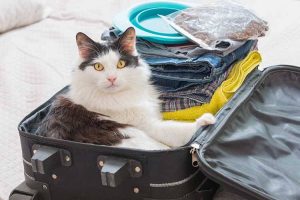Posts Tagged ‘traveling with your pet’
Tips for Traveling with Pets: A Guide from Olsen Veterinary Clinic
 Traveling with pets can be a rewarding experience, but it requires careful planning and preparation to ensure a safe and comfortable journey for both you and your furry companion. Whether you’re taking a road trip, flying, or using public transportation, here are some essential tips to make your travel smooth and enjoyable.
Traveling with pets can be a rewarding experience, but it requires careful planning and preparation to ensure a safe and comfortable journey for both you and your furry companion. Whether you’re taking a road trip, flying, or using public transportation, here are some essential tips to make your travel smooth and enjoyable.
Preparation Before the Trip
- Visit the Veterinarian:
- Schedule a check-up to ensure your pet is healthy and up-to-date on vaccinations.
- Obtain a health certificate if required by your destination.
- Discuss any travel concerns and ask for recommendations on calming aids if your pet is prone to anxiety.
- Microchip and Identification:
- Make sure your pet is microchipped and the information is current.
- Attach an ID tag with your contact information to your pet’s collar.
- Pet-Friendly Accommodations:
- Research and book pet-friendly hotels or lodgings in advance.
- Confirm pet policies, including any restrictions or additional fees.
- Pack Essentials:
- Bring enough food and water for the duration of the trip, plus extra in case of delays.
- Include bowls, a leash, a waste disposal bag, grooming supplies, a first-aid kit, and any medications your pet needs.
- Pack a favorite toy or blanket to provide comfort and a sense of familiarity.
Safety Measures During Travel
- Secure Your Pet:
- Use a pet carrier, travel crate, or a pet seatbelt to keep your pet safe in the car.
- Ensure the carrier is well-ventilated and spacious enough for your pet to stand, turn around, and lie down comfortably.
- Never Leave Pets Unattended:
- Never leave your pet alone in a parked car, as temperatures can quickly become dangerous.
- If you need to stop, take your pet with you or ensure someone stays with them.
- Regular Breaks:
- Plan for regular breaks (every 2-3 hours) to allow your pet to stretch, relieve themselves, and hydrate.
- Use a leash and harness during stops to prevent your pet from running off in unfamiliar surroundings.
Stress-Reducing Strategies
- Comfortable Environment:
- Keep the carrier or crate cozy with your pet’s favorite blanket or bedding.
- Maintain a calm and quiet environment by minimizing loud noises and sudden movements.
- Familiarization:
- Gradually acclimate your pet to their carrier and the car before the trip.
- Take short practice trips to help your pet get used to the sensation of traveling.
- Calming Aids:
- Consider using natural calming aids like pheromone sprays or anxiety wraps.
- Consult with your veterinarian about the use of calming medications if your pet has severe travel anxiety.
- Stay Calm:
- Your pet can sense your emotions, so remain calm and relaxed to help reduce their stress.
- Speak to your pet in a soothing tone and provide reassurance throughout the journey.
Tips for Specific Modes of Travel
- Car Travel:
- Keep windows closed to prevent your pet from sticking their head out, which can be dangerous.
- Use sunshades to block direct sunlight and keep the car cool.
- Air Travel:
- Choose a pet-friendly airline and review their pet travel policies.
- Book a direct flight to minimize stress and reduce the risk of layovers or missed connections.
- Label your pet’s carrier with your contact information and a “Live Animal” sticker.
- Public Transportation:
- Check the specific regulations of the transportation service regarding pets.
- Ensure your pet is comfortable in their carrier and follow any rules regarding pet containment.
By following these tips from Olsen Veterinary Clinic, you can help ensure a safe, comfortable, and stress-free travel experience for you and your pet. Remember, preparation and patience are key to a successful journey with your furry friend. If you ever have any questions about your pet, contact us today. Happy travels!
Tips For Traveling With Your Pet This Summer
 Traveling is an exciting yet stressful time for humans. Bringing your pet along usually adds to the stress level because it brings along extra preparation and attention to detail. Driving and flying each have their own challenges, but with the right advice, traveling with your pet can be a breeze. No matter where you are going or how you get there, it is important to have your pet wearing a collar and tag with your name, phone number, and any other contact information including emergency numbers.
Traveling is an exciting yet stressful time for humans. Bringing your pet along usually adds to the stress level because it brings along extra preparation and attention to detail. Driving and flying each have their own challenges, but with the right advice, traveling with your pet can be a breeze. No matter where you are going or how you get there, it is important to have your pet wearing a collar and tag with your name, phone number, and any other contact information including emergency numbers.
Unless your pet is small enough to ride with you in the cabin of a plane, air travel is extremely stressful but sometimes unavoidable. When flying by plane, it is best to book a direct flight whenever possible. This will decrease the chances that your pet is left on the tarmac during extreme weather conditions or mishandled by baggage personnel during a layover. Also, make sure that your pet’s vaccinations are up-to-date and that their overall health is good dated within ten days of your departure. At your appointment, you can also discuss sedation methods if you suspect that they may become anxious. One of the most important aspects of airline travel with your pet is the crate. The crate should be large enough for your pet to stand, sit, and turn around in comfortably. It should be USDA-approved and lined with shredded newspaper or towels to absorb accidents. Prior to your trip, tape a pouch of food to the outside of the crate so airline personnel will be able to feed your pet in case they get hungry while traveling. The night before you leave, freeze a small dish of water that will be melted by the time they may be thirsty. Make sure that the crate door is securely closed, but not locked, so that airline personal can open it in case of an emergency. Make sure that the crate is marked “Live Animal” as well as your name, cell phone number, emergency phone number, and a photo of your pet. In case your pet escapes, the photo can be a lifesaving measure.
When driving, traveling with pets involve a lot more than just loading the animal in the back seat. It is important to get your pets used to a long trip by taking them on short trips and slowly lengthening the time spent in the car. Keep your pets in a well-ventilated crate or carrier. The crate should be large enough for your pet to stand, sit, lie down and turn around in. Be sure to secure your pet’s crate so that it does not slide in the event of a sudden stop. If you don’t use a crate, be sure to keep your pet in a harness attached to a seat buckle. Be sure to bring a pet-friendly travel kit with food, bowls, leashes, poop bags, medication, and any travel documents. Be sure to bring a favorite toy or pillow to give your pet a sense of familiarity. Be sure to pack plenty of water and avoid feeding your pet in a moving vehicle. Your pet’s travel feeding schedule should start with a light meal three to four hours before departure. Perhaps most importantly, you should never leave your animal alone in a parked vehicle. In hot weather, the car turns into a furnace causing a risk of heatstroke. In cold weather, the car turns into a refrigerator holding in the cold which could lead to freezing to death.
However, you choose to travel with your pet, it is important to do it safely. By following these tips, both your stress and your pets’ stress can be reduced greatly making travel day a lot easier for both of you. If you have more questions about this or anything else regarding your pet, contact our office today!
